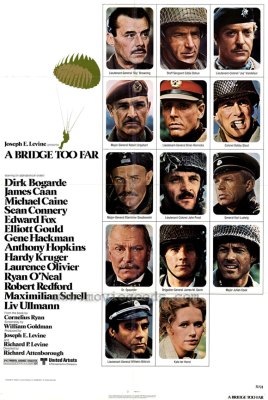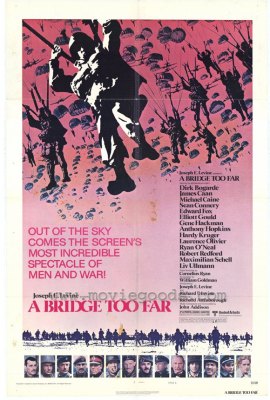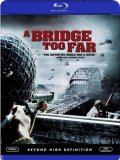| Reviews & Columns |
|
Reviews DVD TV on DVD Blu-ray 4K UHD International DVDs In Theaters Reviews by Studio Video Games Features Collector Series DVDs Easter Egg Database Interviews DVD Talk Radio Feature Articles Columns Anime Talk DVD Savant Horror DVDs The M.O.D. Squad Art House HD Talk Silent DVD
|
DVD Talk Forum |
|
|
| Resources |
|
DVD Price Search Customer Service #'s RCE Info Links |
|
Columns
|
|
|
Bridge Too Far, A
A Bridge Too Far was the last truly epic war movie. Pearl Harbor? Feh. A video game. In A Bridge Too Far, there are no CGI effects; though there are a number of matte shots, most of what's onscreen is real, as are many of the planes, tanks, and other hardware. Some sequences are on such an epic scale they would be impossible, too prohibitively expensive, to shoot today without the aid of CGI. The picture cost $26 million, a lot of money in 1976, but mounting the same film with its 1:1 scale might easily run upwards of $250 million in today's money. Much of the film was actually shot where its battles took place, in a Europe not yet overrun with skyscrapers and Starbucks. Produced just 32 years after the events covered in the film, many of the leading actors were advised how to accurately play their roles by the very people they were portraying, the still-living heroes of Operation Market Garden. And, finally, that mind-boggling cast: Sean Connery, Gene Hackman, Robert Redford, Laurence Olivier, James Caan, Anthony Hopkins, Michael Caine, Dirk Bogarde, and many others. It seems unlikely now that such a stellar list of names could ever be brought together like this again. Indeed, how many actors today even approach that level of charisma and screen presence? No, chances are we'll never see the likes of such films again.
Adapted by director Richard Attenborough (Gandhi) and screenwriter William Goldman (All the President's Men) from Cornelius Ryan's 1974 book of the same name, A Bridge Too Far is an ensemble epic about a September 1944 military operation intended to end the war by Christmas. Spearheaded by Field Marshall Montgomery, who arguably put his own vanity (specifically, his personal competition with U.S. General Patton) ahead of his men's safety, Operation Market Garden parachutes 35,000 troops behind enemy lines into German-occupied Holland, as an advance force to secure strategically vital bridges until Allied reinforcements can arrive.
Though officially "90% successful," the operation is an almost total fiasco. Launched without proper planning, and blithely ignoring evidence of at least one German Panzer tank division in the area, just about everything that could go wrong does. Maj. General Urquhart's (Sean Connery) men are forced to land a full eight miles from their bridge, promised Jeeps fail to show up, and none of the radios work. As the situation deteriorates, men are asked to take outrageous risks - most notably Maj. Julian Cook's (Robert Redford) and his 82nd Airborne's suicidal, mid-day crossing of the Rhine in flimsy canvas and wood boats - or hold positions completely surrounded.
The latter case is exemplified by Lt. Col. Frost (Anthony Hopkins) and his men. They've actually made it all the way to Arnhem, occupying several houses on one end of their bridge only to suffer huge losses when they're greatly outnumbered and besieged by the Germans. These scenes have an intense and authentic air, rather like the long siege on Sarajevo during the Bosnian War; the gradual but total destruction of the picturesque multistory house they occupied carries real weight. (One wonders how all this destruction, which certainly appears to be adjacent to a real bridge and a real neighborhood, was carried out. I wouldn't have wanted to live nearby during filming.)
Re-rated "PG" by the MPAA after their original "R" was appealed, A Bridge Too Far is effectively bleak without being too disturbingly graphic. In this sense it is perhaps less honest than, say, Saving Private Ryan, but the senseless loss of life is conveyed just as well, and in dramatically sounder terms. One such scene has a brave soldier racing through a sniper-ridden area, risking his life to grab supplies dropped by Allied planes. He's shot dead before he can safely return, and the package he lost his life for breaks open: it contains nothing more than dozens of red berets.
The advent of laserdisc and letterboxing, then DVD and more recently HD DVD, high-def broadcasts and Blu-ray have gradually brought about a long-overdue reevaluation of unjustly-maligned epics like A Bridge Too Far. Maybe it's because for three full decades it was virtually impossible to approximate the experience of seeing these films on a big, wide, theater screen. (Except, of course, for the major revivals of films like Lawrence of Arabia, El Cid, and Spartacus, all of which were highly praised.) Maybe it's because we took such big-scale films for granted that; now that this particular type has disappeared and will never return we've become nostalgic for them. Perhaps it was this close and very real connection to the actual war of '60s and '70s World War II epics, versus recent films like Saving Private Ryan and Pearl Harbor, which can only recreate, that make them so fascinating now. Maybe it was timing; after Vietnam, even a film as critical and cynical as A Bridge Too Far was wrongly perceived by many as a nostalgic flag-waver.
Video & Audio
Gorgeously filmed in Panavision by Geoffrey Unsworth, A Bridge Too Far looks appropriately spectacular in this 1920 x 1080p / MPEG-2 transfer. Unsworth and Attenborough like to use long lenses to visually squash men and military hardware together so not everything is in focus at the same time, but nor is this the grainy, soft-focus Unsworth of the early Superman movies, either.
A great many shots are so razor sharp one can see all kinds of details lost in the strong standard-def DVD edition. The massive parachute drop is probably the visual highlight. Truly spectacular, what looks like thousands of troops jump from dozens of planes. In extreme long shots, it looks like Salmon laying thousands of eggs. Covered from dozens of different angles, including cameramen themselves participating in the mass-jump, it's a sequence you'll want to show your friends. I was surprised by the number of optical composite shots of planes as they head for the Netherlands. The DVD presentation fooled this reviewer, but on Blu-ray barely perceptible matte lines reveal that most of the planes in flight are real planes matted in or photographs and/or paintings. The end titles, incidentally, are windowboxed.
The audio is as spectacular as the film. Back in 1977, the film was blown-up to 70mm in big cities and presented in six-track magnetic stereo. The Blu-ray offers 5.1 DTS Lossless HD master audio in its original English with a second, Japanese-dubbed track in 5.1 DTS. The Japanese and English subtitles are optional; when you turn the subtitles off, it defaults to a program where only the German and Dutch dialogue is English-subtitled.
The BAFTA award-winning original mixing, presented here with fully-directional sound effects and dialogue is superb, full of bassy bass and extreme clarity. I was particularly impressed with the balancing of the sound effects track with John Addison's rousing, richly orchestrated score, which sounds wonderful amplified to home theater fullness.
Extra Features
Alas, nothing but a standard-def trailer, along with a few other MGM-related coming attraction previews.
Parting Thoughts
A Bridge Too Far is an unjustly maligned film, the last of the great war epics, one as (surprisingly) cynical and dark as it is spectacular and star-studded. From its opening title design to its visual stunning compositions throughout, this is a big screen movie that comes spectacularly to life on Blu-ray. A DVD Talk Collectors Series Title.
Film historian Stuart Galbraith IV's latest books, Japanese Cinema and The Toho Studios Story, are now available for pre-order.
|
| Popular Reviews |
| Sponsored Links |
|
|
| Sponsored Links |
|
|
| Release List | Reviews | Shop | Newsletter | Forum | DVD Giveaways | Blu-Ray | Advertise |
|
Copyright 2024 DVDTalk.com All Rights Reserved. Legal Info, Privacy Policy, Terms of Use,
Manage Preferences,
Your Privacy Choices | |||||||
















